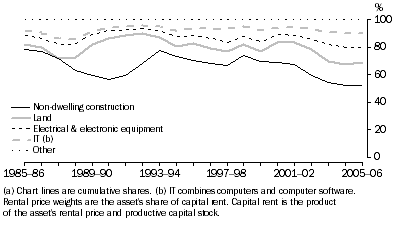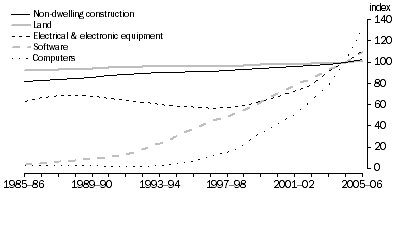CAPITAL INPUTS
Figure 6.7 presents gross fixed capital formation (GFCF) since 1985-86. GFCF growth steadily declined between 1985-86 and 1993-94, but has grown strongly from 1994-95. This strong growth occurred in both non-dwelling construction and machinery and equipment.
ERIG (2007) indicates that a number of utilities have been investing to increase their base load capacity. In addition, the report also indicates some utilities may be increasing their peak capacity. The issue of peak capacity is that it is maintained in a 'semi-reserve' status to be brought online at peak demand. Given that no adjustment is made for capacity utilisation, the current approach to measuring capital services may overstate the capital services flow.
Determining the level of investment based upon type of investment (e.g. peak load capacity and base load capacity) is problematic, because GFCF data cannot differentiate investment by purpose at the detailed level.
6.7 Electricity, gas & water Gross fixed capital formation, Chain volume measures (a)

Figure 6.8 provides a breakdown of rental price weights for the major assets of the Electricity, gas & water industry. The figure shows the non-dwelling construction rental price weight (the asset's share of capital rent) declining due to slower growth in its productive capital stock (figure 6.9). However, non-dwelling construction still has the largest rental price weight. The rental price weights for computers, software and electrical and electronic equipment grew strongly in recent years.
6.8 Electricity, gas & water rental price weights (a)
 6.9 Electricity, gas & water productive capital stock,
6.9 Electricity, gas & water productive capital stock, (2004-05 = 100)

 Print Page
Print Page
 Print All
Print All